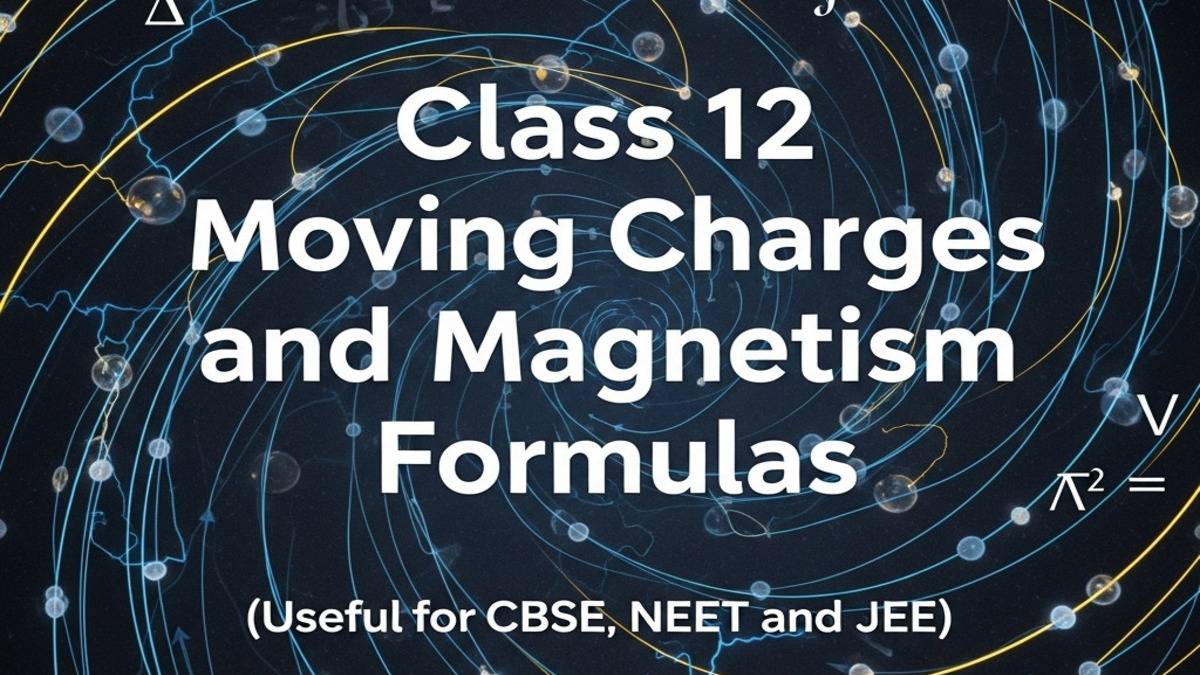Moving Charges And Magnetism Formulas
Find all the important formulas of Class 12 Physics Chapter 4 Moving Charges and Magnetism here. This Formula sheet covers Biot-Savart Law, Ampere’s Circuital Law, magnetic fields, force on moving charges, and more.
A compiled formula list is always a helpful resource for CBSE Board and competitive exam aspirants. We at Shiksha have created a simple and highly useful Moving Charge and Magnetism Formula sheet, which is equally good for quick revision and numerical practice. Solve the NCERT Exercise using the Class 12 Physics chapter 4 formulas provided by Shiksha.
We offer complete study material for all Class 12th Physics chapters. Learn the important concepts of Class 12 Physics Chapter 4 through our NCERT Notes and combine them with quick formula revision for the best results. Memorize Magnetism Formulas and Practice NCERT Exemplar to boost your competitive exam preparation.
- Magnetic Force
- Magnetic force on a current-carrying conductor
- Motion in a Magnetic Field
- Biot-Savart Law
- Ampere’s Circuital Law
- The Solenoid
- Torque on Current Loop
- Magnetic Dipole
- Moving Coil Galvanometer
Magnetic Force
- Lorentz force on a charge (q) moving with velocity (v) in a magnetic field (B) [As vector cross product]:
- Magnitude of Lorentz force
- Lorentz Force when both the Electric and Magnetic fields are acting on the charge
Magnetic force on a current-carrying conductor
- Force on a Straight conductor of length (L) carrying a current (I) in a magnetic field (B)
- Magnitude of force
- Force when the conductor is parallel to B:
- Force when the conductor is perpendicular to B:
Motion in a Magnetic Field
- Path of Motion
- When velocity is perpendicular to the magnetic field, it revolves in a circular path.
- When the velocity vector is parallel to the magnetic field, it revolves in a straight line.
- If the velocity vector has both components, then it revolves in a helical path.
-
Radius of Circular Path
-
Angular Frequency (Cyclotron Frequency)
-
Time Period
-
Pitch of Helix
Biot-Savart Law
This law states that the magnetic field due to a conductor is directly proportional to the current element, at a distance r, at an angle θ.
- Magnetic Field dB due to a Current-carrying conductor due to current element dI, at a distance r:
- Magnitude of the Magnetic field:
- Magnetic Field on the Axis of a Circular Current Loop
- At the center of the loop (x ):
Ampere’s Circuital Law
This law states that the line integral of the magnetic field B around any closed amperian loop is equal to μ₀ times the net current enclosed by the loop.
- Circuital Law Formula
Applications of Ampere's Circuital Law
- Magnetic Field Due to a Long Straight Current-Carrying Wire of Infinite Length
- Magnetic Field Inside a Long Solenoid with n turns per unit length
- Inside a Toroid of radius r with N turns
| Related Physics Class 12 Chapter 4 Study Material |
|---|
| Class 12 Moving Charges and Magnetism NCERT Solutions |
| Physics Moving Charges and Magnetism NCERT Notes |
| Class 12 Physics Chapter 4 NCERT Exemplar Solutions |
| Class 12 Moving Charge and Magnetism Quick Revision Notes |
The Solenoid
It is an electromagnet made by wrapping a metallic wire around a hollow metallic cylinder.
- Magnetic Field Inside a Long Solenoid
- Magnetic Field Inside a Solenoid with Core
- Magnetic Field Outside a Long Solenoid
- Magnetic Flux Through Solenoid
- Force between Two Parallel Current-Carrying Conductors
Torque on Current Loop
- Torque on a Current Loop in a Magnetic Field
- Magnitude:
Magnetic Dipole
- Magnetic Dipole Moment
- Magnitude:
Moving Coil Galvanometer
It is a device to measure small current deflection in a circuit. It is based on the concept of torque on a coil when placed in a magnetic field.
- Deflecting Torque:
- Restoring Torque:
- Reading at Equilibrium:
- Current Sensitivity:
- Voltage Sensitivity:

